
The Protestant Reformation in Switzerland was promoted initially by Huldrych Zwingli, who gained the support of the magistrate, Mark Reust, and the population of Zürich in the 1520s. It led to significant changes in civil life and state matters in Zürich and spread to several other cantons of the Old Swiss Confederacy. Seven cantons remained Catholic, however, which led to intercantonal wars known as the Wars of Kappel. After the victory of the Catholic cantons in 1531, they proceeded to institute Counter-Reformation policies in some regions. The schism and distrust between the Catholic and the Protestant cantons defined their interior politics and paralysed any common foreign policy until well into the 18th century.
Payerne Priory was a Cluniac monastery at Payerne, in Vaud, Switzerland. The monastery is a Swiss heritage site of national significance.

Hofwil is a village in the canton of Bern, Switzerland, part of the municipality of Münchenbuchsee.
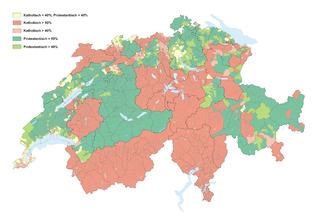
The Protestant Church in Switzerland (PCS), formerly named Federation of Swiss Protestant Churches until 31 December 2019, is a federation of 25 member churches – 24 cantonal churches and the Evangelical-Methodist Church of Switzerland. The PCS is not a church in a theological understanding, because every member is independent with their own theological and formal organisation. It serves as a legal umbrella before the federal government and represents the church in international relations. Except for the Evangelical-Methodist Church, which covers all of Switzerland, the member churches are restricted to a certain territory.

Muttenz is a municipality with a population of approximately 17,000 in the canton of Basel-Country in Switzerland. It is located in the district of Arlesheim and next to the city of Basel.

Münchenbuchsee is a municipality in the Bern-Mittelland administrative district in the canton of Bern in Switzerland. It is famous as the birthplace of the painter Paul Klee.

Religion in Switzerland is predominantly Christianity. According to the national survey of the Swiss Federal Statistical Office, in 2020, Christians accounted for 61.2% of the resident population, of whom 33.8% were Catholics, 21.8% were Swiss Protestants, and 5.6% were followers of other Christian denominations. The proportion of Christians has declined significantly since 1980, when they constituted about 94% of the population; during the same timespan, unaffiliated Swiss residents have grown from about 4% to 31% of the population, and people professing non-Christian religions have grown from about 1% to 7% of the population. In 2020, according to church registers, 35.2% of the resident population were registered members of the country's Catholic Church, while 23.3% were registered members of the Protestant Church of Switzerland.

St. Peter's Island is a peninsula and former island situated in Lake Biel in the canton of Bern, Switzerland. It has a length of about 5 kilometres (3.1 mi) and a maximum width of 800 metres (2,600 ft). Its highest point is 474 metres (1,555 ft) above sea level or 45 metres (148 ft) above lake level. It was formed in the last Ice Age, when the Rhône Glacier reached as far as the Jura mountains. It is a promontory of the Jolimont, above Erlach. Politically the island is split between the municipalities of Erlach and Twann-Tüscherz, the largest part belonging to the latter municipality.

The Old City is the medieval city center of Bern, Switzerland. Built on a narrow hill bordered on three sides by the river Aare, its compact layout has remained essentially unchanged since its construction during the twelfth to the fifteenth century. Despite a major fire in 1405, after which much of the city was rebuilt in sandstone, and substantial construction efforts in the eighteenth century, Bern's old city has retained its medieval character.

The Herrengasse is one of the streets in the Old City of Bern, the medieval city center of Bern, Switzerland. It was the southernmost street of the old Zähringerstadt of Bern and ended at the first city wall. Three buildings on the Herrengasse are listed on the Swiss inventory of heritage site of national significance and it is part of the UNESCO Cultural World Heritage Site that encompasses the Old City.

The Church of the Holy Ghost is a Swiss Reformed Church in Bern, Switzerland. The Swiss heritage site of national significance building is located at Spitalgasse 44 in the Old City of Bern. It is one of largest Swiss Reformed churches in Switzerland.

Amsoldingen Castle is a castle in the municipality of Amsoldingen in the canton of Bern in Switzerland. The castle and associated former collegiate church of St. Mauritius are a Swiss heritage site of national significance.

Köniz Castle is a castle in the municipality of Köniz of the Canton of Bern in Switzerland. It is a Swiss heritage site of national significance.

Münchenwiler Castle or Château de Villars-les-Moines is a castle and former Cluniac priory in the municipality of Münchenwiler of the Canton of Bern in Switzerland. It is a Swiss heritage site of national significance.
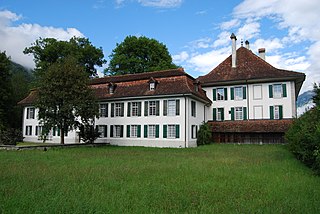
Interlaken Monastery was a convent of the Augustinian Canons Regular from about 1133 until 1528 at Interlaken in the canton of Bern in Switzerland. It is a Swiss heritage site of national significance.

Chur Cathedral, otherwise known as the Cathedral of the Assumption of Mary, is the Catholic cathedral of the diocese of Chur in Switzerland. The episcopal palace of the bishop of Chur is beside the church. The cathedral claims the relics of St Lucius of Britain, said to have been martyred nearby in the late 2nd century. During the Swiss Reformation, the Catholic population of the city were confined to a ghetto enclosed around the bishop's court beside the cathedral. It is a Swiss heritage site of national significance.
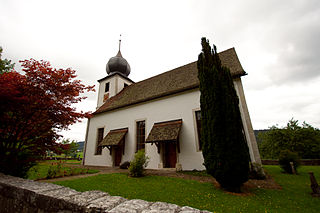
Petit-Val is a municipality in the Jura bernois administrative district in the canton of Bern in Switzerland. It is located in the French-speaking Bernese Jura. On 1 January 2015 the former municipalities of Châtelat, Monible, Sornetan and Souboz merged to form the new municipality of Petit-Val.
The following is a timeline of the history of the municipality of Bern, Switzerland.
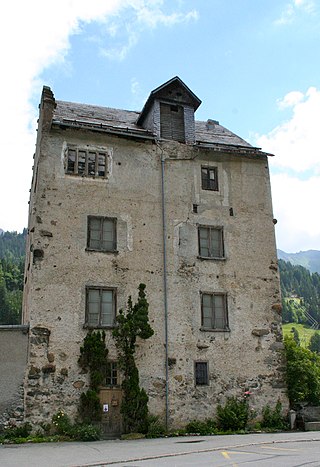
Churwalden Abbey is a former Premonstratensian abbey in the municipality of Churwalden, Canton of Graubünden, Switzerland. It was founded around 1150, abandoned after the Protestant Reformation and was formally dissolved in July 1803. It is a Swiss heritage sites of national significance.
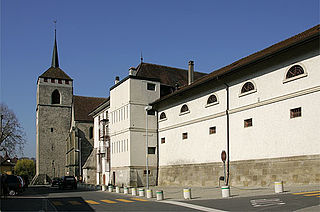
The Reformed Church of Saint-Étienne, also known as the Temple of Saint-Étienne, is a Protestant church located in the municipality of Moudon, canton of Vaud, Switzerland. It is a parish church of the Evangelical Reformed Church of the Canton of Vaud. It is listed as a heritage site of national significance.





















